提出一个疏螺旋体亚属
IF 3.4
2区 医学
Q2 INFECTIOUS DISEASES
引用次数: 0
摘要
2014年,有人提出(2015年有效发表)将疏螺旋体属分为两个属,其中一个新属包含螺旋体莱姆病组的疏螺旋体属,而疏螺旋体属保留所有其他物种。由于疏螺旋体是医学上重要的细菌,并且对这一分类学建议提出了担忧,这种属的分裂是有争议的。特别是,用于支持属划分的遗传特征的准确性受到质疑,特别是近年来新分类群显著增加了属的多样性。因此,2018年提议将疏螺旋体属恢复到其原始形式。但是,有些数据库坚持使用最后一个有效发布的属名作为正确名称的策略,因此无法识别到以前的分类法和以前有效发布的名称(同型同义词)的回归。因此,我们建议将疏螺旋体属的等级降低到一个亚属。这将创建一个比属名Borreliella更新的有效公布名称,然后可以被数据库使用,并提供一种正式引用同一组的方法,而无需暗示物种名称的必要更改。应用未充分利用的亚属分类,而不是将一个已经是单系的属划分为几个属,对其他细菌群来说也是一个更好的解决方案。本文章由计算机程序翻译,如有差异,请以英文原文为准。
Proposing a subgenus Borreliella
In 2014, it was proposed (validly published in 2015) that the genus Borrelia be divided into two genera, with a new genus Borreliella holding species of the Lyme borreliosis group of spirochetes and the genus Borrelia retaining all other species. As borrelias are medically important bacteria and as concerns about this taxonomic proposal were raised, this genus split was controversial. In particular, the accuracy of the genetic signatures used to support the division of the genus has been questioned, particularly as new taxa have markedly increased the diversity of the genus in recent years. Restoration of the genus Borrelia to its original form was therefore proposed as an emendation in 2018.
However, some databases adhere to the policy of using the last validly published name of a genus as the correct name and, hence, fail to recognize a reversion to a previous taxonomy and to previously validly published names (homotypic synonyms). We therefore propose to lower the genus Borreliella in rank to a subgenus. This will create a validly published name newer than the genus name Borreliella that can then be used by databases and provides a means of formally referring to the same group without implying necessary changes of species names. Applying the underused subgenus category instead of splitting an already monophyletic genus into several genera could be a preferable solution for other bacterial groups, too.
求助全文
通过发布文献求助,成功后即可免费获取论文全文。
去求助
来源期刊

Ticks and Tick-borne Diseases
INFECTIOUS DISEASES-MICROBIOLOGY
CiteScore
6.90
自引率
12.50%
发文量
185
审稿时长
6-12 weeks
期刊介绍:
Ticks and Tick-borne Diseases is an international, peer-reviewed scientific journal. It publishes original research papers, short communications, state-of-the-art mini-reviews, letters to the editor, clinical-case studies, announcements of pertinent international meetings, and editorials.
The journal covers a broad spectrum and brings together various disciplines, for example, zoology, microbiology, molecular biology, genetics, mathematical modelling, veterinary and human medicine. Multidisciplinary approaches and the use of conventional and novel methods/methodologies (in the field and in the laboratory) are crucial for deeper understanding of the natural processes and human behaviour/activities that result in human or animal diseases and in economic effects of ticks and tick-borne pathogens. Such understanding is essential for management of tick populations and tick-borne diseases in an effective and environmentally acceptable manner.
 求助内容:
求助内容: 应助结果提醒方式:
应助结果提醒方式:


